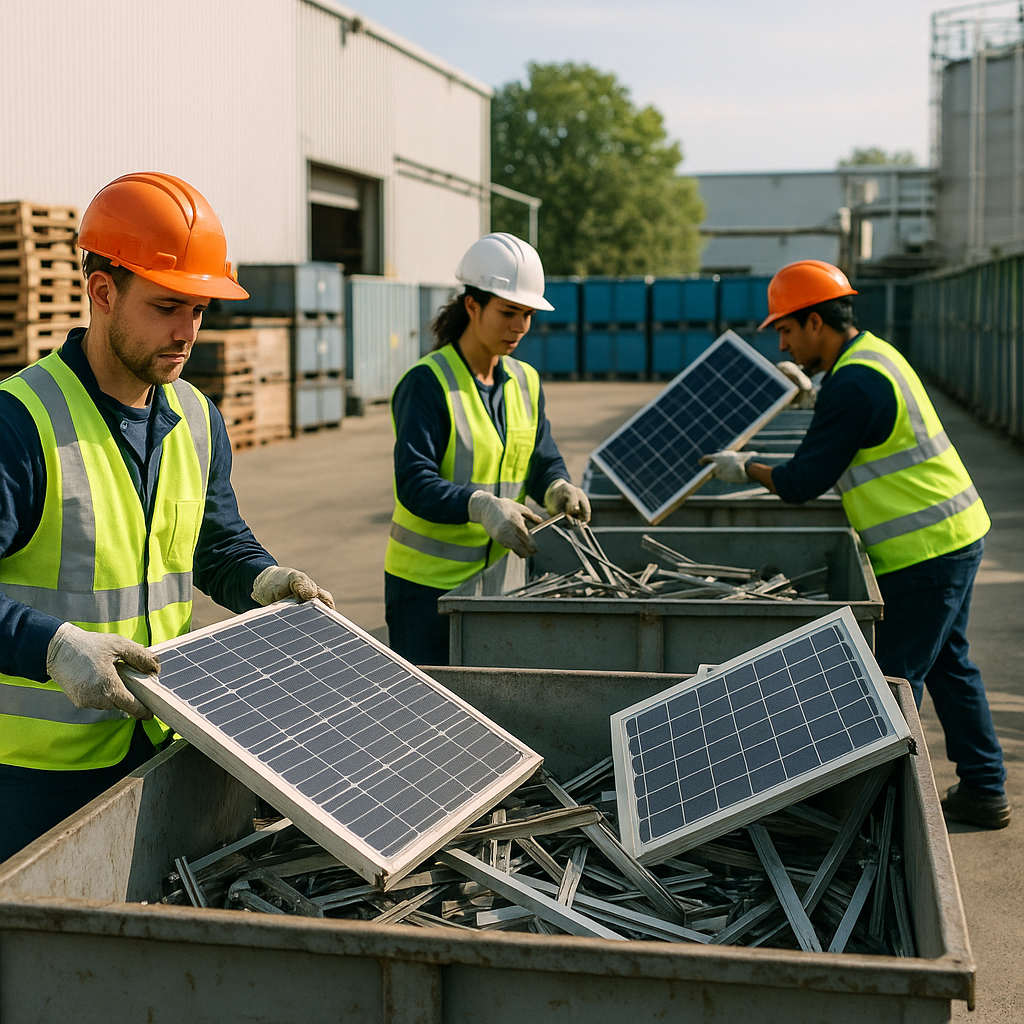5901 Botham Jean Blvd, Dallas, TX 75215
Solar Panel Decommissioning: Costs, Regulations, and Recycling Options in 2025
July 5, 2025Solar farm decommissioning marks the final chapter in a renewable energy site’s lifecycle. This important process involves dismantling and removing solar energy systems once they reach the end of their operational life. Typically, solar farms are designed to function effectively for 20-25 years before performance degradation leads to their retirement.
The decommissioning process includes several key activities. Crews carefully dismantle solar panels, inverters, racking systems, wiring, and other infrastructure components from the site. The focus is on returning the land to its pre-installation state, often for agricultural use. This usually involves removing equipment foundations, restoring soil conditions, and replanting native vegetation.
As the solar industry matures, decommissioning has gained increasing attention. With many early solar installations approaching their end-of-life phase, proper waste management practices have become essential. Responsible decommissioning prevents potential environmental contamination from materials in older panels and ensures the sustainability of renewable energy throughout its lifecycle.
What are the Key Steps in Solar Farm Decommissioning?

Solar farm decommissioning involves a systematic approach to safely remove infrastructure and restore land to its original condition. The process consists of several carefully sequenced steps that ensure environmental protection and resource recovery.
Site Assessment
Before any physical work begins, a comprehensive evaluation of the solar farm site is necessary. Engineers conduct thorough inspections to document existing conditions and identify potential hazards or environmental concerns.
The assessment includes soil testing to detect any contamination, evaluation of infrastructure condition, and creation of a detailed inventory of all components. This critical first step informs the development of a tailored decommissioning strategy that meets regulatory requirements.
Special attention is given to environmentally sensitive areas that may require additional protection during the dismantling process. The assessment also establishes baseline conditions for comparing post-remediation results.
Equipment Dismantling
The dismantling phase begins with disconnecting and isolating all electrical systems to ensure worker safety. Qualified technicians then systematically remove solar panels from mounting structures.
Racking systems, support posts, and foundations are extracted next, followed by the removal of inverters, transformers, and other electrical equipment. Underground cables are carefully excavated to minimize soil disturbance.
Each component is handled according to specific protocols to prevent damage and maximize recycling potential. The dismantling sequence typically follows the reverse order of installation to ensure efficiency and safety.
Waste Management and Material Recovery
Proper handling of decommissioned materials is a crucial environmental responsibility. Components are sorted by material type and condition to determine the appropriate recycling or disposal pathway.
Solar panels contain valuable materials including aluminum, glass, silicon, and copper that can be recovered through specialized recycling processes. Steel mounting structures and copper wiring offer high recycling value.
Any hazardous materials require special handling and processing in compliance with environmental regulations. Clear documentation of all material disposition helps demonstrate regulatory compliance and environmental stewardship.
Site Remediation
The final phase focuses on returning the land to its original condition or preparing it for new use. This process typically begins with soil decompaction to counteract the effects of heavy equipment used during installation and removal.
Grading and contouring restore the natural topography of the site. Native vegetation is replanted to prevent erosion and support the local ecosystem. Access roads are removed unless they provide value for future land use.
Erosion control measures are implemented to protect the restored land during the reestablishment period. Post-remediation monitoring may continue for several months to ensure successful restoration and compliance with environmental requirements.
This comprehensive approach to solar farm decommissioning ensures responsible end-of-life management for renewable energy infrastructure, protecting environmental resources and supporting the circular economy through material recovery.
| Component | Recyclable Materials | Recycling Potential |
| Solar Panels | Glass, Aluminum, Silicon, Silver, Copper | High recovery rates for glass (90-95%) and aluminum (100%) |
| Inverters | Electronic Waste | Can be recycled with electronics |
| Racking Systems | Steel, Aluminum | Recyclable with scrap metals |
| Batteries | Lead, Nickel, Lithium | Handled through battery recycling programs |
What are the Costs Associated with Solar Farm Decommissioning?
Decommissioning costs for solar farms vary significantly based on several key factors. For a standard 2-megawatt solar installation, costs typically range from $60,000 to $150,000. This range reflects the unique characteristics of each project, with final expenses determined by site-specific conditions.
Project size directly impacts the decommissioning budget. Larger facilities with more panels and extensive infrastructure require more labor hours and equipment to dismantle. Location is also crucial, as transportation distances to recycling facilities can significantly affect total costs.
The site’s topography and soil conditions influence restoration expenses. Projects on previously disturbed land may require less intensive restoration work compared to those on pristine sites needing restoration to their original state.
Major Cost Components
Several significant components make up the decommissioning budget:
Panel removal is one of the most labor-intensive aspects of decommissioning. Technicians must disconnect each panel from the electrical system before removing it from the mounting structure. For a typical 2-megawatt farm with thousands of panels, this process alone can cost between $2,000 and $5,000.
Dismantling racking systems typically costs $12,000 to $20,000 for a 2-megawatt facility. This involves removing all supporting hardware, brackets, and mounting structures that held the panels in place. The complexity of the mounting system directly affects labor requirements.
Electrical equipment removal includes disconnecting and removing inverters, transformers, combiner boxes, and wiring throughout the site. This specialized work often costs $8,000 to $15,000 due to the technical expertise required.
Site restoration represents a substantial portion of decommissioning expenses. This includes removing access roads, regrading the land, replacing topsoil, and revegetating the area with native plants. Restoration costs commonly range from $4,000 to $10,000, depending on the land’s intended future use.
Labor and Equipment Expenses
Skilled labor accounts for a significant percentage of decommissioning costs. Electricians, heavy equipment operators, and general laborers all play essential roles. Labor rates vary by region but typically account for 40-50% of the total decommissioning budget.
Equipment rental is another major expense category. Skid steers, excavators, trucks, and specialized tools are needed throughout the decommissioning process. Daily rental rates for heavy machinery can range from $200 to $1,000, depending on the equipment type.
Recycling and disposal fees must also be considered. While some components like aluminum frames and copper wiring have salvage value that can offset costs, other materials may require payment for proper disposal.
Transportation expenses can be substantial, especially for remote sites. Moving equipment and materials to recycling facilities or disposal sites represents a variable cost based on distance and fuel prices.
| Remove Rack Wiring | $2,450 |
| Remove PV Panels | $2,450 |
| Dismantle Racking System | $12,350 |
| Remove Electrical Equipment | $1,850 |
| Break Up and Remove Pads or Ballasts | $1,500 |
| Remove Racking System | $7,800 |
| Remove Cables | $6,500 |
| Remove Ground Screws and Power Poles | $13,850 |
| Remove Fencing | $4,950 |
| Land Grading | $4,000 |
| Seed Disturbed Areas | $250 |
| Truck to Recycling Center | $2,250 |
| Total | $60,200 |
Many jurisdictions now require developers to secure decommissioning bonds or financial assurances to guarantee that funds will be available for proper site restoration at the end of a project’s life. These financial instruments protect landowners and communities from abandoned solar installations.
The solar industry is increasingly focused on improving end-of-life management practices to minimize environmental impacts and reduce costs. Advances in recycling technology and component design may help lower decommissioning expenses in the future while improving material recovery rates.
How are Solar Panels and Components Recycled or Disposed Of?

Solar panels contain several valuable and recyclable materials that can be recovered at the end of their lifecycle. Glass constitutes approximately 75% of a typical silicon-based panel and can be recycled at rates of 90-95%. The aluminum frames, which make up about 10% of a panel, are 100% recyclable. These components are the foundation of current solar recycling efforts.
In the United States, most solar panels are processed at general-purpose glass recycling facilities. These facilities typically recover the glass and metal frames, while the remaining components are often discarded or incinerated. Although this approach is better than landfilling, it fails to capture the full value of these complex devices.
Specialized Recycling Processes
Advanced recycling methods are being developed to recover a greater percentage of materials. These processes generally follow three main steps: removing the frame and junction box, separating the glass and silicon wafer through various methods, and recovering valuable metals like silver, copper, and tin.
Delamination techniques are crucial in solar recycling. These methods separate the panel’s different layers—glass, encapsulant, solar cells, and back sheet—facilitating more complete material recovery. Thermal, chemical, and mechanical approaches are being refined to improve efficiency and reduce environmental impact.
Innovative hydrothermal processes represent the forefront of solar recycling technology. These techniques use high-pressure, high-temperature water to separate components while preserving valuable materials, avoiding hazardous byproducts, and allowing for water filtration and reuse to minimize waste.
Hazardous Material Considerations
Some solar panels contain materials requiring special handling. Cadmium telluride (CdTe) thin-film panels may contain cadmium, and some silicon panels have lead in their solder. These materials can harm human health and the environment if improperly disposed of.
The Resource Conservation and Recovery Act (RCRA) regulates solar panels that qualify as hazardous waste. A Toxicity Characteristic Leaching Procedure (TCLP) test determines whether panels exceed hazardous waste thresholds. Results can vary significantly, even among panels of the same manufacturer and model.
Homeowners with solar installations should contact their state or local recycling agencies for guidance on proper disposal or recycling options. Several specialized companies now offer solar recycling services across the country.
Economic Considerations and Industry Progress
Currently, recycling solar panels costs between $15 and $45 per panel, compared to just $1 to $5 for landfill disposal. This cost differential presents a challenge to the widespread adoption of recycling practices. However, the potential value of recovered materials is substantial.
By 2050, the global value of recoverable materials from solar panels could exceed $15 billion, enough to manufacture approximately 2 billion new panels, creating a circular economy model for the solar industry. Companies like First Solar demonstrate this approach by involving recycling teams during the design phase, ensuring new panels are created with end-of-life recovery in mind.
Extended Producer Responsibility (EPR) programs are gaining traction as a policy approach. Washington state pioneered this model in the U.S., requiring manufacturers to fund collection and recycling for large photovoltaic installations. The European Union has had similar requirements since 2013, resulting in much higher recycling rates compared to the United States.
As the solar industry continues to mature, improved recycling technology and supportive policies will be essential to ensuring solar energy remains a truly sustainable power source throughout its entire lifecycle.
What Regulations Govern Solar Farm Decommissioning?

Regulations for solar farm decommissioning vary significantly across jurisdictions in the United States. As the solar industry matures, more states are implementing specific policies to ensure proper end-of-life management of solar installations.
As of 2023, 31 states have enacted some form of solar decommissioning legislation, with most of these policies emerging in recent years. This surge in regulatory activity highlights the growing recognition of responsible solar farm retirement.
State-Level Regulations
State regulations for solar decommissioning generally fall into several categories based on jurisdictional authority:
States with statewide requirements, such as Minnesota, Montana, and North Dakota, have comprehensive policies that apply uniformly across the state. These typically mandate detailed decommissioning plans and financial assurances before construction begins.
Hybrid approaches, seen in states like Illinois and Wyoming, establish baseline state requirements while allowing local governments to impose stricter standards. This creates a two-tier regulatory framework that balances consistency with local flexibility.
Some states offer optional certification processes. Washington, for example, provides an optional certification in place of individual local permits, streamlining the regulatory process while maintaining environmental safeguards.
Financial Assurance Requirements
Most states with decommissioning policies require financial guarantees to ensure sufficient funds for proper site restoration. These typically take the form of bonds, letters of credit, or other security instruments that protect landowners and communities from bearing decommissioning costs.
The timing of these financial requirements varies by state. In Montana, financial assurance must be provided before the 15th year of operation, while North Dakota requires proof before operations begin and updates every five years thereafter.
As of 2023, only five states with solar decommissioning policies do not specifically require financial assurance: Maryland, Massachusetts, New Jersey, Rhode Island, and Wyoming.
Environmental Protection Standards
Decommissioning regulations typically include specific environmental protection measures. Connecticut, for instance, requires projects over 2 MW on prime farmland to restore the land to productive agricultural use through de-compacting soils, backfilling with native materials, and testing soil quality for farming.
Many states mandate the removal of infrastructure to specific depths. In Texas, all solar components must be removed to three feet below surface grade, while Indiana requires removal to 36 inches below grade with ground restoration to its pre-construction condition.
Waste management protocols are another critical component of decommissioning regulations. Proper handling of potentially hazardous materials from older panels is essential for preventing soil and water contamination.
Federal Oversight
At the federal level, the Bureau of Land Management (BLM) has established decommissioning policies for solar facilities on federal lands, which include requirements for site restoration and financial guarantees.
The Resource Conservation and Recovery Act (RCRA) may apply to solar panel disposal if the panels contain certain hazardous materials. This federal law regulates the management of hazardous and non-hazardous solid waste.
While not specifically focused on decommissioning, federal environmental laws like the Clean Water Act and Endangered Species Act may impose additional requirements for site restoration and habitat protection during the decommissioning process.
The regulatory landscape for solar farm decommissioning continues to evolve as more facilities reach the end of their operational life. Understanding and complying with these regulations is essential for solar farm owners and operators to ensure responsible project closure and site restoration.
Conclusion: The Future of Solar Farm Decommissioning

As the solar industry matures, decommissioning becomes a critical component of the renewable energy lifecycle. The upcoming increase in aging panels poses both challenges and opportunities. Properly managing end-of-life solar panels is essential to preserve the environmental benefits that initially made solar energy appealing.
New recycling technologies are already changing our approach to solar panel end-of-life management. Innovative companies are developing processes to recover valuable materials such as silver, copper, and crystalline silicon, potentially creating a circular economy worth over $15 billion by 2050. At the same time, regulations in states like Washington, New Jersey, and California are establishing frameworks to ensure responsible decommissioning practices become the norm.
For all your recycling needs, including guidance on handling decommissioned solar panels, contact Okon Recycling at 214-717-4083.
